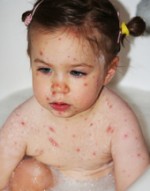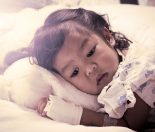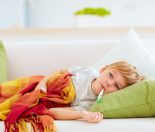Chicken pox is a highly infectious disease characterised by a fever and rash. We provide information and advice about the signs and symptoms, treatments, risks and complications of chicken pox here.
What causes chicken pox?
Chicken pox is a common viral disease caused by the varicella zoster virus that is spread by coughing and sneezing.
It is characterised by slight fever and general cold like symptoms, including a sore throat, followed by a rash that appears a day or two later.
Chicken pox generally occurs in children under 10 and is more common in the late winter and spring.
What are the signs and symptoms of chicken pox?
At first your child may feel unwell with a cold-like illness, with spots following one to two days later.
- Spots first appear as pink/red lumps on the face, scalp, chest, stomach and back.
- The spots are itchy and develop a watery blister on top.
- In turn these blisters burst and form a yellow crust.
- New spots keep occurring for about three to four days while the older spots scab.
Children may have a slight fever, feel miserable and have a headache – though some children do not feel sick at all. In some children there will be sores in the mouth (which makes it hard to eat) and their vagina.
The contagious period for chickenpox is two days before the spots appear until they have all scabbed over, around a week later. Chickenpox is a highly infectious disease and it is wise to keep your child isolated and away from school during this period. The incubation period (from exposure to the virus to when the illness appears) is 11 – 24 days. One attack of the illness normally gives your child immunity for the rest of their life.
It is wise to call a doctor for any rash – especially if your child has a fever, headache or feels very sick. Chicken pox is confirmed when doctors find spots at the three stages: pink lumps, watery blisters and crusted spots.
What is the treatment for Chicken Pox?
It is important to call the doctor if your child:
- has a high fever,
- has lots of blisters, especially near the eyes, and
- refuses to drink anything.
Treatment at home includes rest, trying to prevent scratching of the spots, calamine lotion, keeping up fluid intake and infant paracetamol for fevers, carefully following the instructions on the bottle for age and dosage.
Antihistamines can be given if itching is severe.
Risks & complications of chicken pox
The most common complications of chicken pox (or pocks) are secondary infections caused by bacteria infecting scratched spots.
The virus can be more serious in very young babies, in adolescents and in adults.
As chicken pox can be a risk to an unborn child in early or late pregnancy, always alert the fact that your child has chicken pox to your kindy or school, so that any pregnant mums are aware and can be treated with immunoglobulin if necessary. (This can be used as a short-term protection, to prevent infection in people who have been exposed to chickenpox and would be at risk if they became infected e.g. a pregnant woman or immuno-suppressed child).
In rare cases chickenpox can lead to inflammation of the brain (encephalitis) or pneumonia.
After having chicken pox the virus lies dormant in the body, but can emerge later to cause shingles in adults.
How should I care for my child with chicken pox?
- Try to discourage scratching as much as possible as spots can cause scars.
- Apply calamine lotion to cool and calm the skin.
- Keep your child’s nails short to help prevent scratching and secondary infection
- Ensure your children wash their hands regularly throughout the day.
- It may help to use cotton gloves, mittens or socks on smaller children or at night to stop scratching.
- Dress your children in cool, comfortable clothing.
- Encourage your child to rest
- Keep up fluid intake
- Treat the fever with infant paracetamol carefully following the instructions on the bottle for age and dosage.
- Children’s skin can also be cooled with lukewarm flannels or in a lukewarm bath. Adding baking soda or cornstarch to the bath water will help calm itching (a cup per bath). Alternatively, Pinetarsol will have the same effect.
- If eating is uncomfortable, give soft foods and plenty of fluids
Helpful Articles
Visit our Fever article for great information on caring for a child with fever.
Visit www.medikidz.com/articles/medtozeds/chicken_pox for a chicken pox photo and explanation for your child.







Fantastic Sites…
[…]this is absolutely fantastic, added your site to my list[…]…